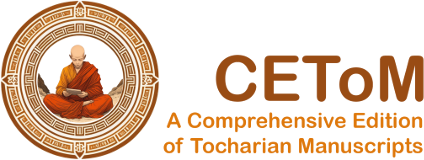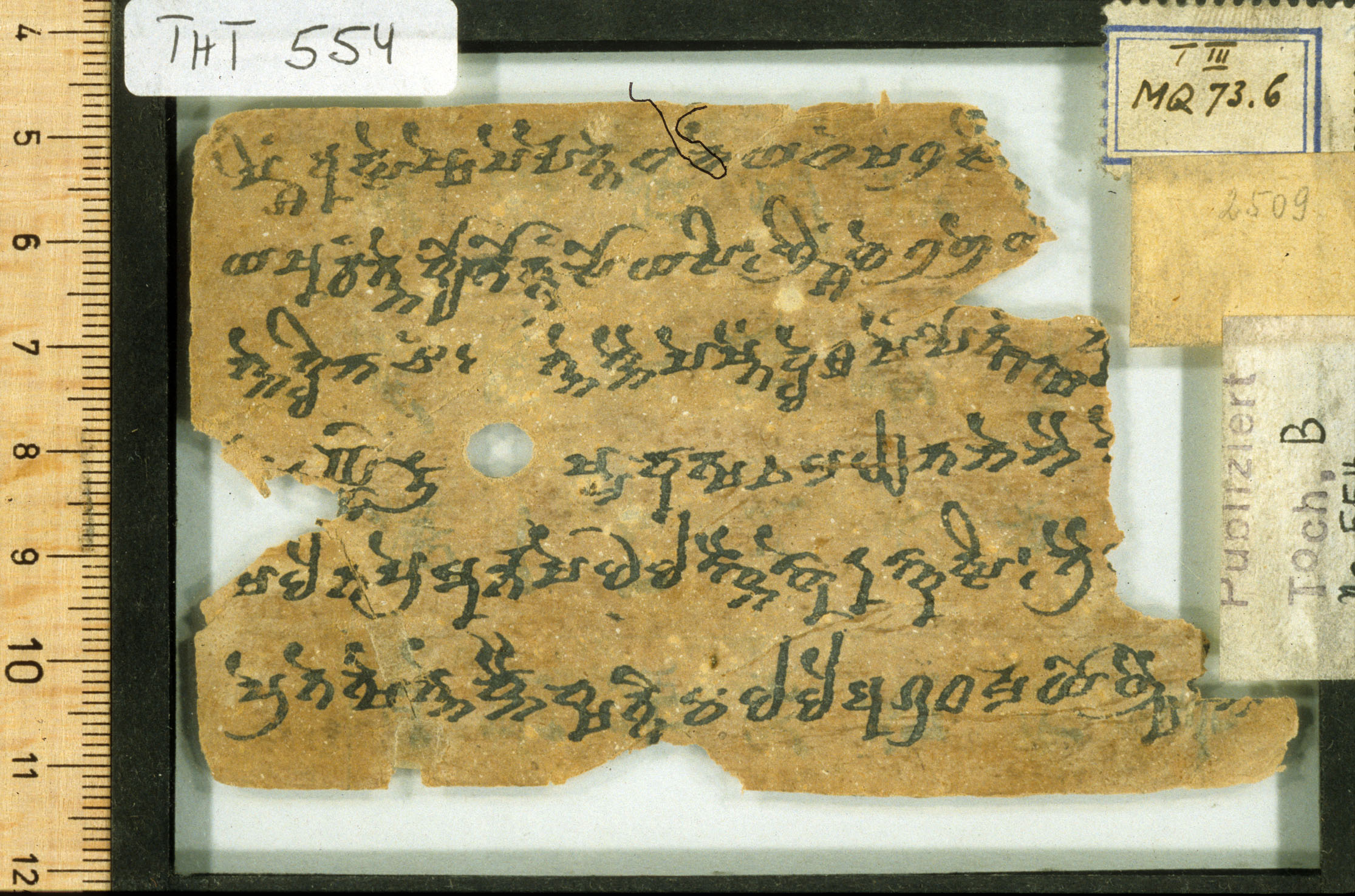THT 554
| Known as: | THT 554; B 554; Bleistiftnummer 2509 |
|---|---|
| Cite this page as: | Adrian Musitz (translation). "THT 554". In A Comprehensive Edition of Tocharian Manuscripts (CEToM). Created and maintained by Melanie Malzahn, Martin Braun, Hannes A. Fellner, and Bernhard Koller. https://cetom.univie.ac.at/?m-tht554 (accessed 05 Jul. 2025). |
Edition | |
| Editor: | Adrian Musitz (translation) |
Provenience | |
| Main find spot: | Kizil Ming-öy |
| Expedition code: | T III MQ 46, T III 73.6 |
| Collection: | Berlin Turfan Collection |
Language and Script | |
| Language: | TB |
| Linguistic stage: | archaic |
| Add. linguistic characteristics: | late |
| Script: | classical |
Text contents | |
| Title of the work: | Praise of the Āryamarga |
| Text genre: | Literary |
| Text subgenre: | Doctrine |
| Verse/Prose: | verse |
| Meter: | 4343 (4x) |
Object | |
| Manuscript: | THT 552-557 |
| Preceding fragment: | THT 553 |
| Material: | ink on paper |
| Form: | Poṭhī |
| Number of lines: | 6 |
Images
Images from idp.bbaw.de by courtesy of the International Dunhuang Project Berlin, the Berlin-Brandenburgische Akademie der Wissenschaften, and the Staatsbibliothek zu Berlin – Orientabteilung.
Transliteration
(continues from THT 553)
| a1 | tsi : a rya ma rkṣai ke· ts· [r]ts· wi mū kti nta ka la lyi wi mo kṣ[ä] |
|---|---|
| a2 | ṣi kuse twe ri twe knai a rte ma ske ntraṃ : saṃ sa rṣe pi [c]ke t·e ·e – |
| a3 | – ·y· ya taṃ pa ta tsi 10-1 kle śa nma ṣṣi sta – – – |
| a4 | wa ka rne ke¯ ¯t• wi tsko • lai tki a tsi ka ra kna ·e – – |
| a5 | tne spä nto s̝a : ai śa mñe ṣe pe re tsa ta ·[e] – – – – |
| a6 | stsi : pa ñai tre ṅke cme la ṣṣe tne klau tka si – – – – |
| b1 | pi¯ ¯ś• a tse ṣṣe pe rpe tte ta ne ya taṃ ṣa la s[i] – – – – |
| b2 | ya ṣu caṃ tne kyo to nt[ra]ṃ so ya si : ñi¯ ¯ś• we la ñe [y]· – – – |
| b3 | tne [k]li na s̝aṃ : tne [k]nai pe ṣteṃ kle śa ṣeṃ po ntaṃ¯ ¯ts [k]· – – |
| b4 | – – [10]-[3] [ū] ṣm[a] k[a] tṣa e ma lya ta ne nai ·e – – – |
| b5 | ṣ[a] le ta pre mu rta ṣe o la ṅknai ṅke ra ṅka tsi : nrai – – – |
| b6 | pre te nṣe tne knai kṣa [nt]i ka la le a gra dha rma yo ñyai – |
Transcription
(continues from THT 553)
| 11a | a1°tsi : |
|---|---|
| 11b | aryamarkṣai ; ke(ṃ)ts= (au)rts(ai) ; wimūktinta ; kälalyi |
| 11c | wimokṣäa2ṣi ; kuse tweri ; t{w→n}ek nai arte ; mäskentr-äṃ : |
| 11d | saṃsarṣepi ; cket·e ·e ; – a3 – ·y· yataṃ ; patätsi 10-1 |
| 12a | kleśanmaṣṣi ; sta – – ; – a4 wakärne ; ket witsko • |
| 12b | laitki atsi ; karakna ; ·e – – a5 tne ; späntoṣä : |
| 12c | aiśamñeṣe ; peretsa ; tä·e – – ; – – a6 °stsi : |
| 12d | pañai treṅke ; cmelaṣṣe ; tne= klautkäsi ; – – – – |
| 13a | b1 piś atseṣṣe ; perpette ; täne yatäṃ ; ṣaläsi |
| 13b | – – – – ; b2 yaṣucaṃ ; tne-k yotonträṃ ; soyasi : |
| 13c | ñiś weläñe ; y· – – – ; b3 tne= ; klinaṣäṃ : |
| 13d | tne-k nai peṣteṃ ; kleśaṣeṃ ; pontaṃts k· – ; – b4 – – 10-3 |
| 14a | ūṣmakatṣa ; emalya ; tane nai (ṅk)e ; – – – |
| 14b | b5 ṣale tapre ; murtaṣe ;n1 olaṅk nai ṅke ; raṅkatsi : |
| 14c | nrai(ṣṣe) (lwāṣṣe) ; b6 pretenṣe ; tne-k nai kṣanti ; kälale |
| * | agradharma yoñyai(ne) |
|---|
Translation
(continues from THT 553)
| a1 | ... (ways of) release are obtainable on the wide ground of the noble path. |
|---|---|
| a1+ | The doors of vimokṣawhich are here neglected, ... will be able to stop (?) (the flow) of the Saṃsāra-river. |
| a3+ | The Kleśa-trees... whose root, dense lianas, branches... |
| a5 | Here, the faithful ones (fell) them with the axe of wisdom... |
| a6 | ... to turn the clinging of the births here into pañai(?)... |
| b1 | Then they will be able to throw off the burden of the five skandhas. |
| b1+ | ... here he can satisfy the beggars... |
| b2+ | ... saying "I"... is necessary here... |
| b3+ | Here the peṣtes and Kleśas... of all... |
| b4 | Burning heat here... |
| b5 | It is then easy to climb a mountain with a high summit. |
| b5+ | Certainly one can have forgiveness with hell, animals and pretas. |
| b6 | On the way of the foremost law... |
Other
| a1+ | The [types of] salvations can be attained in the wide land of Āryamarga [11b]; those who are the doors (= blockades?) of the vimokṣa are indifferent [11c]; they are able to dam the power of the saṃsāra river 11. Those who trust are able to (eradicate?) the kleśa trees, whose roots, lianas, branches and twigs [are] in the highest existence, with the axe of wisdom [12c], and they (are able) to turn away from the clinging to existence and glory (12). They are able to throw off the burden of the five skandhas [13a]. Those asking for food and drink can be satisfied [13b]. It is necessary to … [give up?] saying «I» [13c]. Here the peṣte (= fetter?) of the kleśas is (cut off?) for all 13. The heat of exaltation [is] then here … [14a], the high mountain of exaltation is then easy to climb [14b], mercy for the hell-beings, animals and pretas can be obtained [14c], the path of Agradharma … (Peyrot 2013b: 664) |
|---|---|
| b1+ | Die (um Essen [und] Trinken) Bittenden können nur hier gesättigt werden. (Schmidt 1974: 112) |
| b5+ | le pardon destiné aux êtres infernaux, aux animaux et aux revenants ne peut être obtenu qu'ici en vérité. (Meunier 2013: 152) |
Commentary
Philological commentary
| Virāma is spelled with dot so that several ‹ṃ› in the translation of Sieg and Siegling 1953 have to be deleted. | |
| n1 | murtaṣeis mūrdhan"summit". |
Alternative linguistic/paleographic classifications
| Peyrot 2008 | A2 |
| Tamai 2011 | A3 |
| Tamai 2011 | C14 |
References
Online access
Edition
Translations
Meunier 2013: b5 b6 (152); Peyrot 2013b: a1 a2 a3 a4 a5 a6 b1 b2 b3 b4 b5 b6 (664); Schmidt 1974: b1 b2 (112); Sieg and Siegling 1983: b1 (147); Thomas 1952: a1 (29), b6 (31); Thomas 1954: b1 (724), b2 (724), b5 (746); Thomas 1957: a3 a4 a5 a6 (274); Thomas 1969: a1 (259); Thomas 1979b: a1 a2 (20), a6 (21), b1 (15), b1 b2 (21), b4 (15), b5 b6 (21)
Bibliography
“The International Dunhuang Project: The Silk Road Online.” n.d. http://idp.bl.uk.
Meunier, Fanny. 2013. “Typologie des locutions en yām- du tokharien.” Tocharian and Indo-European Studies 14: 123–85.
Peyrot, Michaël. 2008. Variation and change in Tocharian B. Vol. 15. Leiden Studies in Indo-European. Amsterdam/New York: Rodopi.
Peyrot, Michaël. 2013b. The Tocharian subjunctive. A study in syntax and verbal stem formation. Vol. 8. Brill’s Studies in Indo-European Languages & Linguistics. Leiden/Boston: Brill.
Schmidt, Klaus T. 1974. “Die Gebrauchsweisen des Mediums im Tocharischen.” PhD, Universität Göttingen.
Sieg, Emil, and Wilhelm Siegling. 1953. Tocharische Sprachreste. Sprache B, Heft 2. Fragmente Nr. 71-633. Edited by Werner Thomas. Göttingen: Vandenhoeck & Ruprecht.
Sieg, Emil, and Wilhelm Siegling. 1983. Tocharische Sprachreste. Sprache B. Teil I: Die Texte. Band 1. Fragmente Nr. 1-116 der Berliner Sammlung. Edited by Werner Thomas. Neubearbeitet und mit einem Kommentar nebst Register versehen v. Werner Thomas. Göttingen: Vandenhoeck & Ruprecht.
Tamai, Tatsushi. 2011. Paläographische Untersuchungen zum B-Tocharischen. Innsbrucker Beiträge zur Sprachwissenschaft 138. Innsbruck: Institut für Sprachen und Literaturen.
Thomas, Werner. 1952. Die tocharischen Verbaladjektive auf -l. Deutsche Akad. der Wissenschaften zu Berlin, Institut für Orientforschung 9. Berlin: Akademie-Verlag.
Thomas, Werner. 1954. “Die Infinitive im Tocharischen.” In Asiatica. Festschrift Friedrich Weller. Zum 65. Geburtstag, gewidmet von seinen Freunden, Kollegen und Schülern, edited by Johannes Schubert and Ulrich Schneider, 701–64. Leipzig: Harrassowitz.
Thomas, Werner. 1957. Der Gebrauch der Vergangenheitstempora im Tocharischen. Wiesbaden: Harrassowitz.
Thomas, Werner. 1969. “Bemerkungen zum Gebrauch von toch. A ptāñkät [B pañäkte, pudñäkte], A koṃ [B kauṃ]: A koṃñkät [B kauṃñäkte] usw.” Orbis 18: 235–68.
Thomas, Werner. 1979b. Formale Besonderheiten in metrischen Texten des Tocharischen: Zur Verteilung von B tane/tne “hier” und B ñake/ñke “jetzt”. Abhandlungen d. Geistes- und Sozialwissenschaftlichen Klasse 15. Mainz: Verlag d. Akad. d. Wissenschaften und d. Literatur.
Gippert, Jost, Katharina Kupfer, Christiane Schaefer, and Tatsushi Tamai. n.d. “Thesaurus Indogermanischer Text- und Sprachmaterialien (TITUS): Tocharian Manuscripts from the Berlin Turfan Collection.” http://titus.fkidg1.uni-frankfurt.de/texte/tocharic/thtframe.htm.




